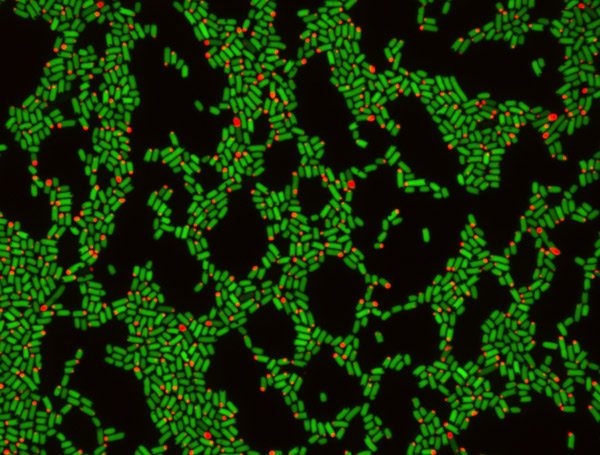Gut Reactions: Hertz Fellow Cameron Myhrvold Examines Life Cycle of Cells in the Digestive System
There’s been a great deal of discussion in the scientific community recently about the importance of studying microbes in the gut, and how a better understanding of this “gut ecosystem” might help humans fight off infection or develop more effective antibiotics.
Enter Hertz Fellow and Harvard PhD candidate Cameron Myhrvold, who, along with his colleagues, has devised a new method for measuring the growth rate of gut microbes called distributed cell division counting, or DCDC. The method uses genetically encoded particles that are distributed into the cells and measured when the cells divide. The team’s findings were published on November 30 in Nature Communications.
“The microbes could be responsible for a lot of things we can’t explain yet,” Myhrvold said, comparing the study to the search for dark matter. “We’ve gotten a snapshot of what’s going on (in the gut) and we’re starting to see what’s happening with regards to disease, diet and behavior. There seem to be a lot of effects.”
The DCDC method is a new take on the “mark and recapture” technique first developed in the 19th century, Myhrvold said. Fluorescent particles, visible under a microscope, are induced inside of cells, “marking” those that have been bio-engineered. They’re counted before and after they pass through the digestive tract, to gather information on how the microbes are growing and changing over time.
In mice, Myhrvold said, researchers are seeing a fraction of the “bright” cells decreasing as they pass through the gut, indicating rapid changes occur in digestive system when a person changes their diet, travels, or otherwise alters their lifestyle.
“We think a lot of the cells must be dying, and that death plays an important role in regulating the microbes in the gut,” Myhrvold said.” People had thought for a long time that the gut microbiota was mostly static. But we’re finding evidence that that’s not the case.”
The study is ongoing into the dynamics of the gut microbiome, said Myhrvold, whose latest research follows his work at Harvard using synthetic RNA as a structural material and a regulator of gene expression. Earlier this year, Myhrvold and his colleagues published a review paper in Nature Structural and Molecular Biology on using nanotechnology to design programmed “scaffolding” made of RNA, self-assembled inside and outside of cells, to both organize the enzymes and control the expression of genes.
Potentially, the science could help researchers understand the structure of DNA itself, “mark” cells, and better control which enzymes are expressed. Engineering bacteria could be used to make more useful molecules; fragrances, plastics, biofuels, and prescription drugs such as the anti-malaria drug Artemisinin, which was previously only derived from rare plants and complicated to manufacture in the lab.
Perhaps most importantly, Myhrvold said, the technology could be used to program the behavior of T-cells, encouraging the immune system to attack only cancer cells, for example, instead of healthy cells.
“You can produce the molecule that you want to make more easily,” he said. “We’re inspired by nature’s example, but we’re trying to expand it to places that haven’t evolved yet. You’re really getting the cells to target the pathogens you want to target and you can control them better with a scaffold.”
Born and raised in Seattle, Myhrvold, who will be 27 in January, enjoyed math and biology growing up, and had a deep love of animals, wildlife and photography. After being home-schooled throughout his high school years, he graduated magna cum laude from Princeton University in 2011, where he studied the evolution of quorum sensing, earning an AB in molecular biology and a certificate in quantitative and computational biology.
After receiving his Hertz Fellowship, he moved on to Harvard, where he became interested in synthetic biology after taking a course on it. He joined the Molecular Systems Lab and the Silver Lab in 2012 where he began working with his advisors Dr. Pamela Silver and Dr. Peng Yin, thus merging two of his interests, synthetic biology and nucleic acid nanotechnology.
“I like the design aspect because it allows you to be creative with the structures but there’s also a lot of applications,” he said. “It’s also fairly new, and I think the labs at Harvard were a natural way to combine those interests.”
Myhrvold, who enjoys hiking, backpacking, photography and scuba diving, is on track to earn his doctorate in May and, though he’s leaning toward remaining in academia, is still contemplating his next steps.
